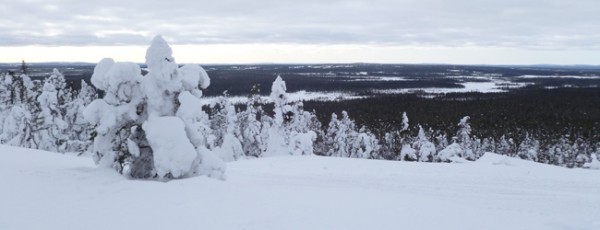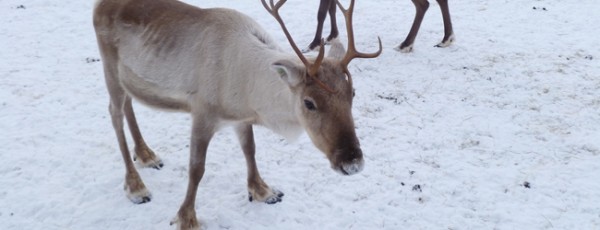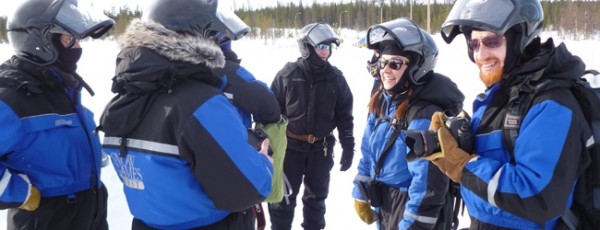Travelling on location in Finnish Lapland with The Location Guide
I see the Northern Lights shimmer across the sky just minutes after stepping off the plane in Finnish Lapland. I’m in Rovaniemi on the border of the Arctic Circle, known internationally as the official home of Santa Claus.
 Along with three European producers, I’ve been invited by the Finnish Lapland Film Commission to visit the region and explore what it has to offer international production companies. My fellow travellers are Wolf Stundl, a producer with Wunderfilm in Hamburg, Angus MacDonald, a Milan-based producer, and Ciara McGowan, a producer with Pretzel Films in London. We’re also joined on our trip by Oskari Huttu of KOMIA Helsinki.
Along with three European producers, I’ve been invited by the Finnish Lapland Film Commission to visit the region and explore what it has to offer international production companies. My fellow travellers are Wolf Stundl, a producer with Wunderfilm in Hamburg, Angus MacDonald, a Milan-based producer, and Ciara McGowan, a producer with Pretzel Films in London. We’re also joined on our trip by Oskari Huttu of KOMIA Helsinki.
The Santa Claus link is of course Lapland’s biggest international claim to fame. Santa is a big brand here and a successful tourism industry has built up around the man and the myth. Rovaniemi’s Santa Park is a subterranean attraction that features an ice sculpture gallery, an elf school and Santa’s office, not to mention all the cuddly reindeer visiting children could ever want.
The Santa Claus element makes Lapland seem somehow more remote and inaccessible. The reality is very different. Rovaniemi is only a short hop by air from the Finnish capital Helsinki, which itself is only a few hours’ reach of major European hubs like Hamburg, Milan and London.
Everything is housed behind a 14-tonne blast door in a former nuclear bunker. It’s a creative use of available space that’s sure to play into the imaginations of visiting children and it’s also available for location filming.
But of course there’s a lot more to Lapland than a rotund gentleman in a red suit. The Santa element is actually a bit of a mixed blessing for Lapland’s filming industries because one psychological effect is that it makes the region seem somehow more remote and inaccessible. The reality is, of course, very different. Rovaniemi is only a short hop by air from the Finnish capital Helsinki, which itself is only a few hours’ reach of major European hubs like Hamburg, Milan and London.
Given that Lapland offers an extended winter where snow is guaranteed and the local crew base is ready and waiting, it should really be on the shortlist of every producer looking for snow in Europe, especially for commercial projects. The crew base and the professionalism and dedication of the locals are major assets, while funding support is available for international co-productions working with a Finnish producer.
There isn’t a formal film incentive yet, but the locals are working on it. The industry has seen a busy few years, with five features shot since 2008, most of which were produced regionally or from within Europe. Lapland has also hosted its fair share of TV shows and documentaries – most of which are again local – in addition to higher-profile commercials for brands including Heineken and Audi. The RED ONE and RED EPIC are among the standard regional cameras.
It’s March in Lapland so the Ravaniemi sun rises at about 7:30am and sets at about 5:30pm. Given the town’s northerly location the sun doesn’t set at all through July. In December the day is less than four hours long.
We spend the first two nights of our trip in a very comfortable eight-bedroom log cabin about 80 minutes’ drive from Rovaniemi near the Pyhä-Luosto skiing resort. It’s March in Lapland so the Rovaniemi sun rises at about 7:30am and sets at about 5:30pm. Given the town’s northerly location the days get longer as summer approaches and the sun doesn’t set at all through July. In December the day is less than four hours long.
Staying near Pyhä-Luosto allows easy access to the surrounding countryside where staff at the Kopara reindeer farm and Erä-Susi Husky Farm offer an insight into Lapland’s deeply-rooted cultural relationship with the animals. Both centres are in high demand from visiting film crews and generations of experience are on offer for producers.
Wolf Stundl comments: “I’m very impressed with the people we’ve met. Anssi at the reindeer park was very knowledgeable and it was inspiring to hear about his family’s 200-year connection with the reindeer and the land. It’s a big advantage to know that people you need to make productions work are right here.”
Anssi at the reindeer park was very knowledgeable and it was inspiring to hear about his family’s 200-year connection with the reindeer and the land. It’s a big advantage to know that people you need to make productions work are right here.
Wolf Stundl, Wunderfilm
Further Finnish hospitality can be found in Kemijärvi, which is the northernmost city in the country. This is a part of Lapland where the landscape surprises, as the city offers lakeside sand beaches during the summer, as well as the breathtaking vistas of the River Kemijoki – the longest in Finland – and Lake Kemijärvi, both of which are mostly frozen when we visit. Despite its northerly location, the city offers local equipment rental and a crew base, and is only a short drive from Rovaniemi.
While Lapland delivers the locations and the production support, merely getting around can be an adventure. Snowmobiles are our main mode of transport as we scout the sights around Pyhä-Luosto. Local hire firms provide the machines themselves, as well as heavy-duty snow boots and bodysuits that are brilliant at keeping the heat in and the cold out; very necessary considering winter temperatures fall to around -6 Degrees Celsius in March. We face a low of about -11 during our trip.
Snowmobiles are easy to drive and can reach speeds of some 100km/h over open ground (which is quite a rush on a frozen lake!), although bear in mind you need a valid driver’s licence if you want to take control of one yourself.
Lacking a driver’s licence I’m relegated to passenger (the machine itself can comfortably accommodate three including the driver), but this actually has its advantages for people new to Lapland as it means you can focus on the sights rather than having to pay too much attention to the road. Special pathways are set aside for snowmobiles and it’s best to keep to them as the snow on either side of the track can be a lot deeper than it appears on first glance.
Creatively, Lapland is very inspiring. We saw lots of great visuals that could inspire commercial campaigns right off the bat. My feeling is that they can cope with any scale of production, even if extra crew need to be brought in.
Angus MacDonald, Producer
Angus MacDonald was as impressed as his industry colleagues about what he found on the trip: “Creatively, Lapland is very inspiring. We saw lots of great visuals that could inspire commercial campaigns right off the bat. My feeling is that they can cope with any scale of production, even if extra crew need to be brought in. The biggest challenge is going to be convincing the larger advertising agencies that this is the place to come.”
Production crews won’t be stuck for things to do in their downtime, either. Saunas are a fundamental part of Finnish culture - most modern apartments even have one built in – and they’re a terrific way to wind down. Alternating between the sauna and a hot tub is the way to go and when the hot tub lies on the bank of a frozen lake and you time your session for sunset the views are nothing short of sensational; a blissful experience for the mind and body.
On our last night we visit Snowland in Rovaniemi, which offers an igloo restaurant with tables and a bar all made of ice and compacted snow. The structure takes about seven weeks to build over a mesh framework and as a memorable place to enjoy a tipple with a group of friends it’s a potential wrap party venue too.
The snow guarantee in Lapland is excellent and is the region’s main appeal. It’s an exotic location that’s easy to get to.
Wolf Stundl, Wunderfilm
The quality of the food also deserves a mention, with some of the more exotic items on the Lapland menu including reindeer and brown bear, as well as fantastic fish dishes, all of which should appeal to producers looking to eat well while on location.
Wolf concludes: “The snow guarantee in Lapland is excellent and is the region’s main appeal. It’s an exotic location that’s easy to get to. It shows that there are other options besides global favourites like Canada, which is always useful to know especially for companies based in Europe.”
Lapland has a huge amount to offer the international filming industries but there’s still work to do to heighten its global brand awareness and to change perceptions of its accessibility. A formal incentive will make things easier, but at the moment the can-do attitude of the Finnish Lapland Film Commission and its partners is a strong base on which the region’s industry can continue to grow.
Related Posts
- Speaking with Evan Thomason, Economic Development Associate of the Santa Clarita Film Office
- Cannes Soiree Partner 2013: Finnish Lapland Film Commission
- Metrafilms shoots on location in Finnish Lapland for Beeline’s winter campaign
- Filming in Swedish Lapland with Location Scout Susanne Karlsson
- Johanna Karppinen appointed CEO of Finnish Film & Audiovisual Export
- ABC’s The Bachelor travelled to Lapland in search of the northern lights
- The Location Guide helps organise Finnish Lapland familiarisation trip
- Filming out of the ordinary in Lapland
Related posts:
Comments
Not Logged in
You must be logged in to post a comment





There are no comments